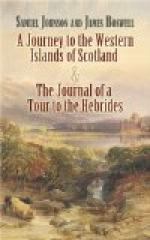In pastoral countries the condition of the lowest rank of people is sufficiently wretched. Among manufacturers, men that have no property may have art and industry, which make them necessary, and therefore valuable. But where flocks and corn are the only wealth, there are always more hands than work, and of that work there is little in which skill and dexterity can be much distinguished. He therefore who is born poor never can be rich. The son merely occupies the place of the father, and life knows nothing of progression or advancement.
The petty tenants, and labouring peasants, live in miserable cabins, which afford them little more than shelter from the storms. The Boor of Norway is said to make all his own utensils. In the Hebrides, whatever might be their ingenuity, the want of wood leaves them no materials. They are probably content with such accommodations as stones of different forms and sizes can afford them.
Their food is not better than their lodging. They seldom taste the flesh of land animals; for here are no markets. What each man eats is from his own stock. The great effect of money is to break property into small parts. In towns, he that has a shilling may have a piece of meat; but where there is no commerce, no man can eat mutton but by killing a sheep.
Fish in fair weather they need not want; but, I believe, man never lives long on fish, but by constraint; he will rather feed upon roots and berries.
The only fewel of the Islands is peat. Their wood is all consumed, and coal they have not yet found. Peat is dug out of the marshes, from the depth of one foot to that of six. That is accounted the best which is nearest the surface. It appears to be a mass of black earth held together by vegetable fibres. I know not whether the earth be bituminous, or whether the fibres be not the only combustible part; which, by heating the interposed earth red hot, make a burning mass. The heat is not very strong nor lasting. The ashes are yellowish, and in a large quantity. When they dig peat, they cut it into square pieces, and pile it up to dry beside the house. In some places it has an offensive smell. It is like wood charked for the smith. The common method of making peat fires, is by heaping it on the hearth; but it burns well in grates, and in the best houses is so used.
The common opinion is, that peat grows again where it has been cut; which, as it seems to be chiefly a vegetable substance, is not unlikely to be true, whether known or not to those who relate it.
There are water mills in Sky and Raasa; but where they are too far distant, the house-wives grind their oats with a quern, or hand-mill, which consists of two stones, about a foot and a half in diameter; the lower is a little convex, to which the concavity of the upper must be fitted. In the middle of the upper stone is a round hole, and on one side is a long handle. The grinder sheds the corn gradually into the hole with one hand, and works the handle round with the other. The corn slides down the convexity of the lower stone, and by the motion of the upper is ground in its passage. These stones are found in Lochabar.




